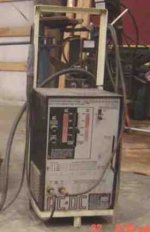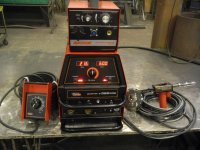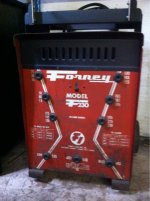IslandTractor
Super Star Member
- Joined
- Sep 15, 2005
- Messages
- 15,802
- Location
- Prudence Island, RI
- Tractor
- 2007 Kioti DK40se HST, Woods BH
As I am one of those "uninformed" individuals, LOL, I just asked someone what the term Buzz Box means compared to the term Inverter unit. From what I was gathering, I was thinking the Buzz Box was a wire fed MIG unit compared to an Inverter that was the "tombstone" stick welder. Was I right?
Buzz box is a term that refers to a cheap transformer based stick welder (SMAW, shielded metal arc welding). All buzz boxes are stick welders. Not all stick welders are buzz boxes. Expensive high power SMAW equipment is not referred to as a buzz box. Buzz boxes as noted work with a transformer power supply and as such are necessarily heavy. Inverter based SMAW welders use more modern electronic systems to minimize the size of transformer needed to perform the function of the copper or aluminum windings in a traditional transformer (see explanation below) and so are much lighter (15lbs for a 150amp inverter vs ?80-100lbs for equivalent power in a buzz box). Most (?all) buzz box welders are tombstone shaped (Lincoln is the classic) so they are often referred to as tombstones but that can get tricky as other higher end welders can look similar. We are only talking about stick or SMAW welders when talking buzz box. MIG welders are never called buzz boxes even if they have a transformer.
Explaining the difference between transformer and inverter welding power supplies (from a website):
A traditional welding power supply uses a large, iron-core transformer to convert low amperage, high voltage AC into high amperage, low voltage AC. A rectifier is then used to convert the AC into DC for use in the welding process. The transformer in this type of power supply typically needs to be quite large to work correctly.
An inverter welder first uses a rectifier to convert the incoming AC into DC. This current is the switched on and off very quickly, creating a pulsed, high frequency direct current. Typical frequencies range from 10,000 to 20,000 Hz, although frequencies as high as 100,000 Hz are possible. The high-frequency, low-amperage current is fed into a transformer where it is changed into high amperage DC, before being rectified again.
These have several advantages when compared to a traditional welding power supply. Both require a transformer to convert incoming current to suitable welding current, though with an inverter welder, this can be done more efficiently at higher frequencies; as a result, the inverter is able to use a much smaller transformer. The result is a substantial reduction in size and weight. Power consumption also decreases as the more efficient transformer loses less energy to heat. It is possible to run an these welders on typical 115 VAC household current due to lower input voltage requirements.



